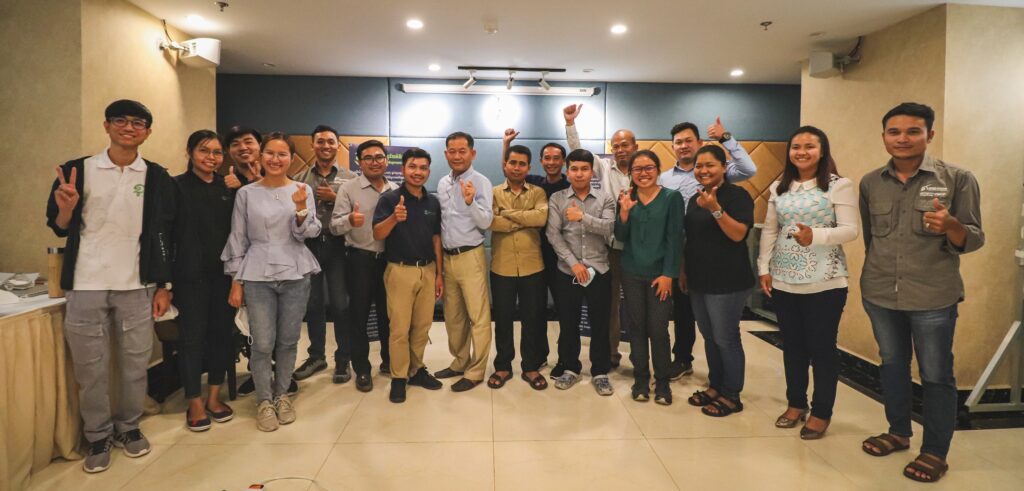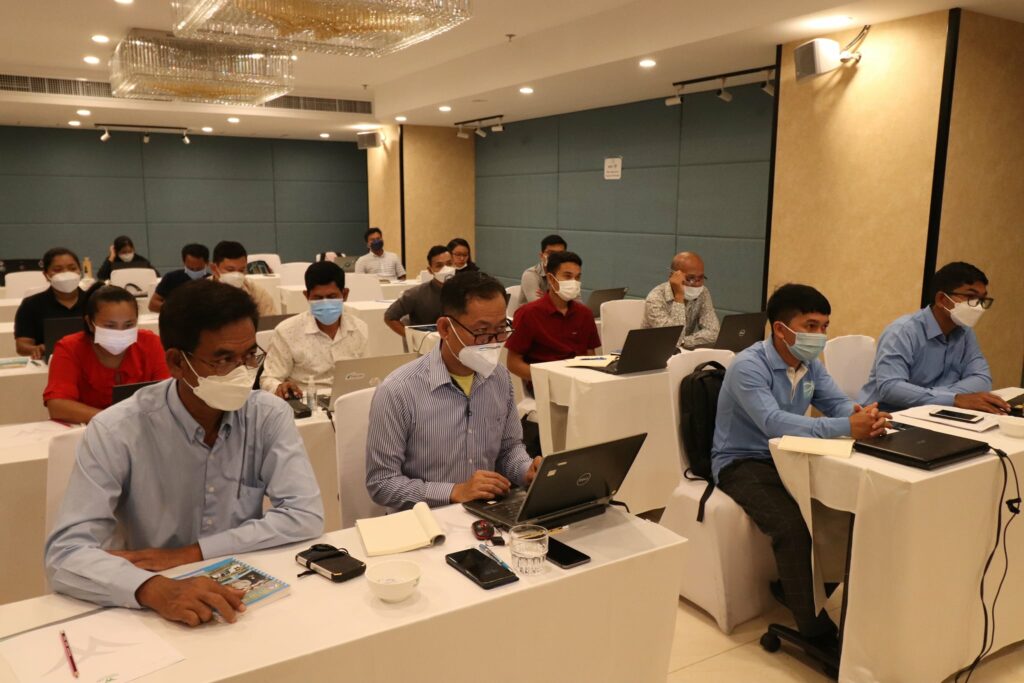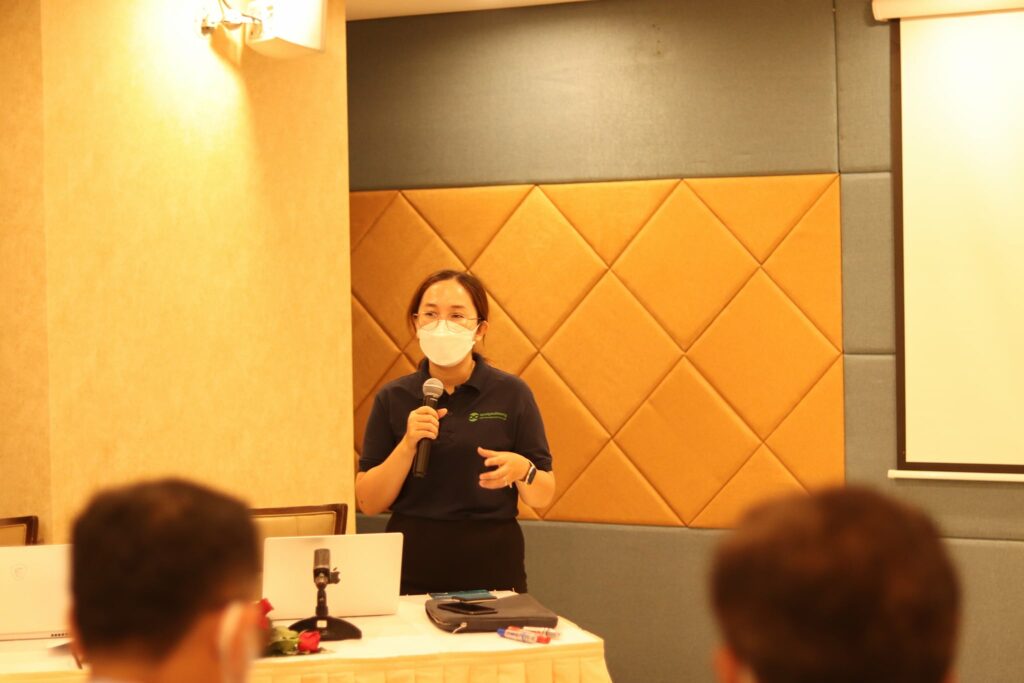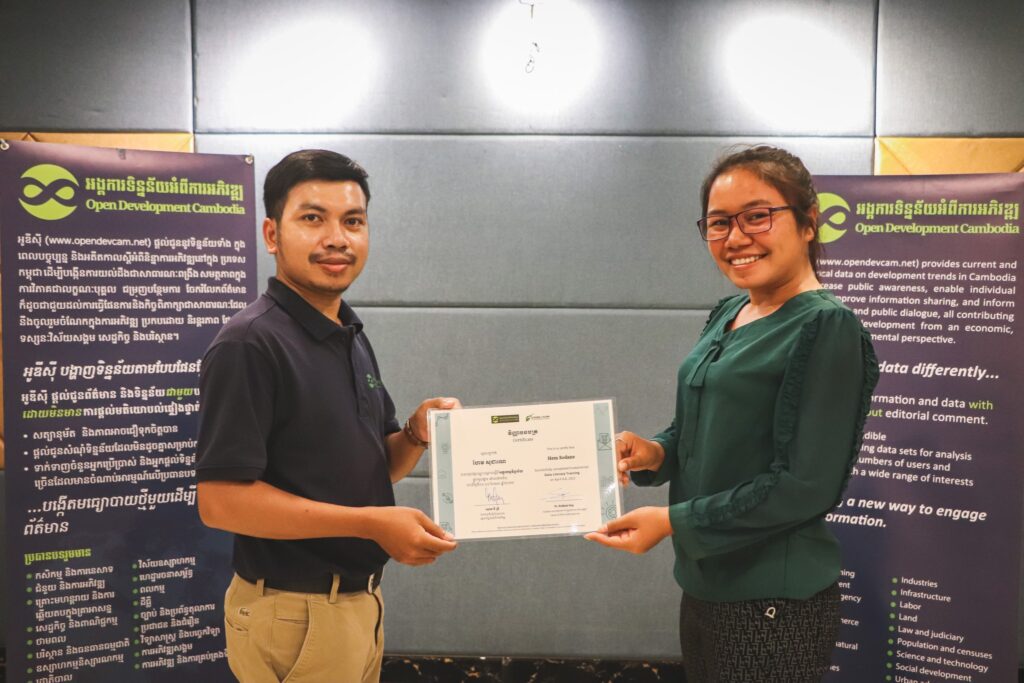វគ្គបណ្តុះបណ្តាលអក្ខរកម្មទិន្នន័យ FFI ត្រូវបានបញ្ចប់ដោយជោគជ័យ
នៅថ្ងៃទី ០៦ ដល់ទី ០៨ ខែមេសា ឆ្នាំ ២០២២ អង្គការទិន្នន័យអំពីការអភិវឌ្ឍហៅកាត់ថា អូឌីស៊ី សហការជាមួយអង្គការសត្វព្រៃ និងរុក្ខជាតិអន្តរជាតិ (FFI)បានបើកវគ្គបណ្តុះបណ្តាលអក្ខរកម្មទិន្នន័យមូលដ្ឋានប្រកបដោយជោគជ័យនៅសណ្ឋាគារពូលូវៃ ដោយមានការគាំទ្រផ្នែកហិរញ្ញវត្ថុពីមូលនិធិ Blue Action Fund ក្រោមគម្រោង “ការពង្រឹងតំបន់ការពារសមុទ្រ (MPAs) អភិបាលកិច្ចវិស័យជលផល និងជីវភាពរស់នៅសហគមន៍តាមតំបន់ឆ្នេរក្នុងប្រទេសកម្ពុជា”។ បន្ទាប់ពីបានបញ្ចប់ការវាយតម្លៃតម្រូវការសមត្ថភាពក្នុងចំណោមដៃគូគម្រោង (FFI, FCEE, FACT, SSF, CWDCC) អ្នកចូលរួមចំនួន ១៦ នាក់ (ស្រី ៣ នាក់) ដែលបានចូលរួមក្នុងគម្រោង MPAs ក្នុងតំបន់គោលដៅ ត្រូវបានអញ្ជើញឱ្យចូលរួមក្នុងវគ្គបណ្តុះបណ្តាលនេះ។ មន្ត្រីរាជការមកពីក្រសួងបរិស្ថាន និងរដ្ឋបាលជលផលខេត្តព្រះសីហនុ ក៏បានចូលរួមផងដែរ។ ព្រឹត្តិការណ៍រយៈពេលបីថ្ងៃបានបំពាក់សិក្ខាកាមនូវជំនាញទិន្នន័យដែលមានប្រយោជន៍ និងចាំបាច់ រួមទាំងការសម្អាតទិន្នន័យ ការវិភាគ និងការនិទានរឿងទិន្នន័យ។ ប្រធានបទដែលទាក់ទងនឹងតំបន់ការពារដែនសមុទ្រ ត្រូវបានប្រើដើម្បីផ្តល់ជាមូលដ្ឋានគ្រឺះដល់ការស្គាល់ ដែលអនុញ្ញាតឱ្យពួកគេយល់យ៉ាងស៊ីជម្រៅអំពីទិន្នន័យ ការប្រើប្រាស់ឧទាហរណ៍ជាក់ស្តែង និងការមើលឃើញពីផលប៉ះពាល់ភ្លាមៗនៃការមើលឃើញទិន្នន័យនៅក្នុងជីវិតប្រចាំថ្ងៃរបស់ពួកគេ។
អង្គការអូឌីស៊ី បានផ្តល់នូវវគ្គបណ្តុះបណ្តាលអក្ខរកម្មទិន្នន័យមូលដ្ឋាន(DLT) យ៉ាងសកម្មសម្រាប់អ្នកពាក់ព័ន្ធផ្សេងៗ រួមមានមន្ត្រីរដ្ឋាភិបាល មន្ត្រីអង្គការក្រៅរដ្ឋាភិបាល អ្នកសារព័ត៌មាន និងនិស្សិត។ វគ្គបណ្តុះបណ្តាលនេះធានាថា សិក្ខាកាមដែលបានចូលរួមនឹងទទួលបានចំណេះដឹងជាមូលដ្ឋាន និងការវិភាគទិន្នន័យ ទស្សនីយកម្មទិន្នន័យ និងជំនាញការនិទានរឿងទិន្នន័យ។ សិក្ខាកាមនឹងអាចប្រើប្រាស់ទិន្នន័យដែលមានស្រាប់ អាន និងបង្កើតព័ត៌មានពីទិន្នន័យ ហើយនៅទីបំផុតអនុញ្ញាតឱ្យពួកគេបង្កើតការនិទានរឿង និងទស្សនីយកម្មទិន្នន័យ ដើម្បីពិពណ៌នា បញ្ជូនសារ និងបង្កើនការយល់ដឹងអំពីបញ្ហាណាមួយ។ កម្មវិធីបណ្តុះបណ្តាលក៏នឹងបង្រៀនអំពីការប្រើប្រាស់ឧបករណ៍ដែលទាក់ទងនឹងទិន្នន័យដូចជា Flourish និង Turbula ផងដែរ។
កម្មវិធីបណ្តុះបណ្តាលរយៈពេលបីថ្ងៃនឹងផ្តោតទៅលើមេរៀនសំខាន់ៗចំនួនបួន ។ ម៉ូឌុល១៖ ការយល់ដឹងអំពីទិន្នន័យ ម៉ូឌុល២៖ ការសម្អាតទិន្នន័យជាមូលដ្ឋាន ម៉ូឌុល៣៖ ការវិភាគទិន្នន័យជាមូលដ្ឋាន និង ម៉ូឌុល៤៖ ការនិទានរឿងទិន្នន័យជាមូលដ្ឋាន។ ម៉ូឌុលទាំងនេះត្រូវបានបង្រៀន និងដឹកនាំដោយលោក វង្ស ពិសិដ្ឋ (មន្ត្រីជាន់ខ្ពស់ផ្នែកស្រាវជ្រាវទិន្នន័យ និងប្រព័ន្ធព័ត៌មានភូមិសាស្ត្រ (GIS)) លោក ឡុច កល្យាណ (អ្នកស្រាវជ្រាវទិន្នន័យ និងឯកទេសប្រព័ន្ធព័ត៌មានភូមិសាស្ត្រ (GIS) និងលោក សំអាន ម៉ារឌី (ប្រធានគ្រប់គ្រងផ្នែកព័ត៌មានវិទ្យា និងគេហទំព័រ)។
លោកស្រី ស៊ីវ វឌ្ឍនា ប្រធានផ្នែកស្រាវជ្រាវ និងគ្រប់គ្រងមាតិកាគេហទំព័ររបស់អង្គការអូឌីស៊ី បានថ្លែងសុន្ទរកថាស្វាគមន៍ ដើម្បីចាប់ផ្តើមវគ្គបណ្តុះបណ្តាលអក្ខរកម្មទិន្នន័យ។ គាត់បានថ្លែងអំណរគុណទៅដល់ម្ចាស់ជំនួយដែលអនុញ្ញាតឱ្យកម្មវិធីបណ្តុះបណ្តាលនេះកើតឡើង។ លោកស្រីសង្ឃឹមថាអ្នកចូលរួមទាំងអស់នឹងទទួលបាននូវជំនាញកម្រិតខ្ពស់ទាក់ទងនឹងទិន្នន័យ ហើយសង្ឃឹមថាគ្រប់គ្នានឹងប្រើប្រាស់បានយ៉ាងពេញលេញនូវអ្វីដែលពួកគេបានរៀនពីកម្មវិធីនេះ។ បន្ទាប់ពីវគ្គណែនាំខ្លីៗរវាងគ្រូបណ្តុះបណ្តាល អ្នកសម្របសម្រួល និងអ្នកចូលរួម អ្នកគ្រប់គ្នាហាក់ដូចជាបង្ហាញពីភាពស្វាហាប់ក្នុងការរៀន។
នៅថ្ងៃដំបូង អ្នកចូលរួមបានសិក្សាម៉ូឌុល ១ និង ២។ ដូចទៅនឹងឈ្មោះនៃម៉ូឌុលនីមួយៗ អ្នកចូលរួមត្រូវបានបង្ហាញពីគំនិតជាមូលដ្ឋាននៃទិន្នន័យ និយមន័យរបស់វា ទំនាក់ទំនងរវាងទិន្នន័យ និងការនិទានរឿង ប្រភេទ និងលក្ខណៈផ្សេងៗនៃទិន្នន័យ និងរបៀបដែលទិន្នន័យអាចត្រូវបានប្រើដើម្បីវិភាគ និងបង្កើតការនិទានរឿង។ ជាងនេះទៅទៀត លោក ឡុច កល្យាណ និងលោក សំអាន ម៉ារឌី បានណែនាំដល់អ្នកចូលរួមក្នុងការសម្អាតទិន្នន័យដោយប្រើកម្មវិធី Google Spreadsheet ។ ការសម្អាតមានគោលបំណងធានាថាទិន្នន័យមានស្តង់ដារត្រឹមត្រូវមុនពេលវិភាគ និងដោះស្រាយបញ្ហាក្នុងទិន្នន័យដូចជា វាលមិនពេញលេញ ទម្រង់ផ្សេងគ្នា ធាតុស្ទួន និងការខុសអក្ខរាវិរុទ្ធ។ នៅចុងបញ្ចប់នៃថ្ងៃទី ១ សិក្ខាកាមអាចអនុវត្ត និងប្រើប្រាស់អ្វីដែលពួកគេបានរៀននៅលើការអនុវត្តផ្ទាល់។ ថ្ងៃដំបូងត្រូវបានបញ្ចប់ដោយរលូន។
ថ្ងៃទីពីរចាប់ផ្តើមជាមួយនឹងសំណួររំលឹកមេរៀនមួយចំនួនដោយលោក វង្ស ពិសិទ្ធ។ គាត់បានសួរអ្នកចូលរួមពីអ្វីដែលពួកគេបានរៀនពីថ្ងៃដំបូង។ បន្ទាប់មក គាត់បានចាប់ផ្តើមបង្រៀនមេរៀនដោយផ្អែកលើម៉ូឌុលទី៣។ គោលដៅចំបងនៃម៉ូឌុលនេះ គឺដើម្បីពង្រឹងការវិភាគទិន្នន័យជាមូលដ្ឋានដល់អ្នកចូលរួមទាំងអស់។ មេរៀនដែលមាននៅថ្ងៃទី ២ គឺសម្មតិកម្ម ការបង្កើតជាសំណួរសម្រាប់ការវិភាគទិន្នន័យ ទស្សនីយកម្មទិន្នន័យ និងការបង្ហាញពីកម្មវិធី Flourish (ឧបករណ៍ទស្សនីយកម្មទិន្នន័យ)។ អ្នកចូលរួមត្រូវបានតម្រូវឱ្យបង្កើតសម្មតិកម្មមួយដែលដើរតួជាលក្ខណៈវិនិច្ឆ័យសំខាន់សម្រាប់ការវិភាគទិន្នន័យ។ អ្នកចូលរួមក៏បានពិសោធន៍ជាមួយប្រភេទតារាងទិន្នន័យខុសៗគ្នា ដែលតំណាង និងបម្រើគោលបំណង និងប្រភេទទិន្នន័យផ្សេងៗគ្នា។ ម៉ូឌុលទី ៣ មានការអនុវត្តជាក់ស្តែងបន្ថែមទៀត នៅពេលដែលអ្នកចូលរួមរៀនវិភាគទិន្នន័យដោយប្រើ Google Spreadsheet និងបង្កើតទស្សនីយកម្មទិន្នន័យដោយប្រើកម្មវិធី Flourish ។ ថ្ងៃទី ២ មានសកម្មភាពច្រើនជាងថ្ងៃទី ១។ អ្នកចូលរួមត្រូវធ្វើការជាក្រុម ហើយបានធ្វើការផ្លាស់ប្តូរចំណាប់អារម្មណ៍ និងគំនិតរបស់ពួកគេ។
បន្ទាប់មក ម៉ូឌុលទី ៤ ដែលផ្តោតលើការនិទានរឿងទិន្នន័យគឺស្ថិតនៅក្នុងរបៀបវារៈថ្ងៃចុងក្រោយនៃកម្មវិធីបណ្តុះបណ្តាល។ ថ្ងៃទីបីបានចងក្រងចំណេះដឹង និងជំនាញចាំបាច់ទាំងអស់ដែលអ្នកចូលរួមបានរៀននៅថ្ងៃទី ១ និងថ្ងៃទី ២ ដើម្បីបង្កើតរឿងរ៉ាវអំពីទិន្នន័យ។ លោក សំអាន ម៉ារឌី បានធ្វើបាឋកថាស្ដីពីការសម្រួលការរកឃើញទិន្នន័យ។ វគ្គនេះអនុវត្តជំនាញការគិតបែបស៊ីជំរៅ ដែលតម្រូវឱ្យអ្នកចូលរួមបំប្លែងទិន្នន័យទៅជាពាក្យសាមញ្ញដែលអ្នកអានអាចយល់បាន។ វិធីមួយចំនួនក្នុងការធ្វើឱ្យទិន្នន័យមានភាពសាមញ្ញរួមមាន:
- បំប្លែងទិន្នន័យពីភាគរយទៅជាប្រភាគ
- ការបំប្លែងទិន្នន័យក្នុងទម្រង់ស្ថិតិទៅជាគោលគំនិតដែលងាយស្រួលប្រាប់
- ការបង្គត់ទសភាគ និងប្រភាគ និងការប្រៀបធៀបទិន្នន័យ។
វគ្គសំខាន់មួយទៀតគឺគោលការណ៍នៃការរចនាតារាងទិន្នន័យ។ លោក វង្ស ពិសិទ្ធ បានធ្វើការណែនាំដល់ថ្នាក់លើការរៀបចំតារាងទិន្នន័យឱ្យសមនឹងប្រភេទទិន្នន័យផ្សេងៗគ្នា និងបង្កើនតម្លៃនៃទិន្នន័យដល់អ្នកអាន។ វគ្គចុងក្រោយនៃថ្ងៃទី ៣ គឺជាវគ្គអនុវត្ត។ អ្នកចូលរួមស្វែងយល់ពីកម្មវិធី Flourish និងព្យាយាមបង្កើតរឿងទិន្នន័យផ្ទាល់ខ្លួនរបស់ពួកគេក្នុងទម្រង់ជាតារាងអន្តរកម្ម។ វគ្គបណ្តុះបណ្តាលអក្ខរកម្មផ្នែកទិន្នន័យត្រូវបានបញ្ចប់ដោយពិធីប្រគល់វិញ្ញាបនបត្រ។ អ្នកចូលរួមម្នាក់ៗត្រូវបានបញ្ជាក់ថាពួកគេបានបញ្ចប់វគ្គបណ្តុះបណ្តាលចំណេះដឹងផ្នែកទិន្នន័យ។
អ្នកចូលរួមមួយចំនួនបានបញ្ចេញទស្សនៈនិងចំណាប់អារម្មណ៍របស់ពួកគេក្នុងកម្មវិធីបីថ្ងៃនេះ។ អ្នកចូលរួមម្នាក់មកពីរដ្ឋបាលជលផលខេត្តព្រះសីហនុ នៃមន្ទីរកសិកម្ម រុក្ខាប្រមាញ់ និងនេសាទ មានប្រសាសន៍ថា វគ្គបណ្តុះបណ្តាលនេះមានសារៈសំខាន់សម្រាប់រដ្ឋបាលជលផល ដើម្បីការពារ និងវិភាគទិន្នន័យជលផលដែលមានស្រាប់ និងអនុញ្ញាតឱ្យគាត់បកស្រាយទិន្នន័យស្ថិតិទៅជារបាយការណ៍។ អ្នកចូលរួមម្នាក់ទៀតមកពី FFI បានជំរុញឱ្យភាគីពាក់ព័ន្ធផ្សេងទៀតដែលមិនទាន់បានចូលរួមក្នុងវគ្គបណ្តុះបណ្តាលនេះអោយចូលរួម ព្រោះវាបានផ្តល់នូវជំនាញមានសារៈសំខាន់ក្នុងការរៀបចំ ការគ្រប់គ្រង និងការធ្វើទស្សនីយកម្មទិន្នន័យ។






